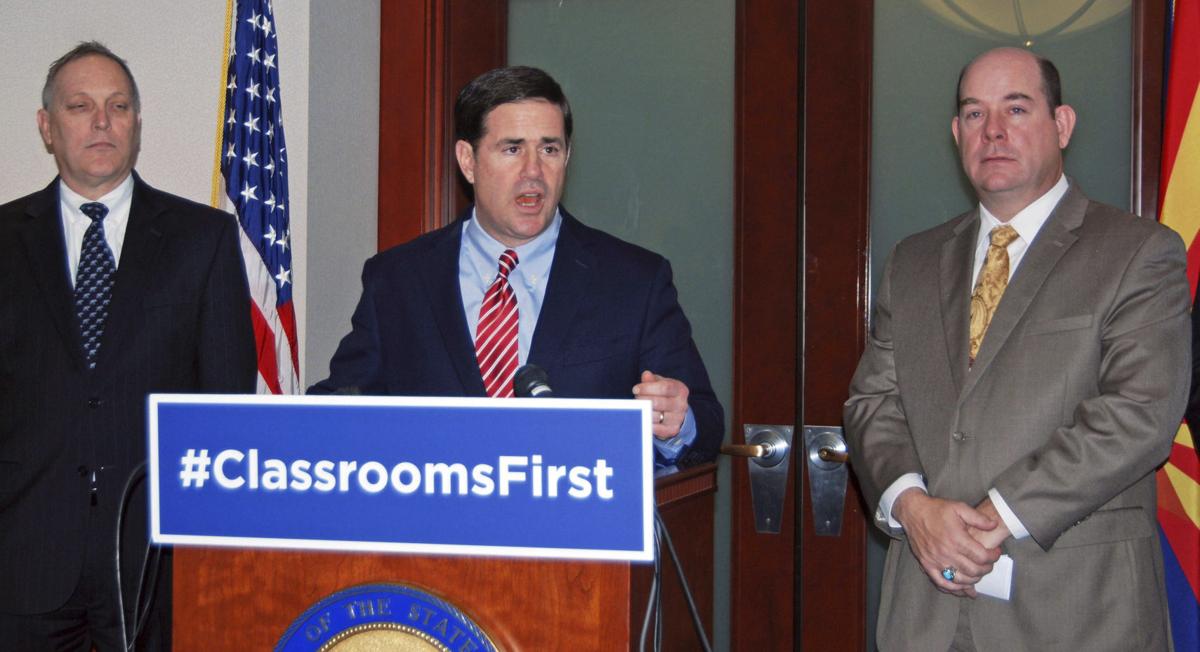PHOENIX — Gov. Doug Ducey penned his approval Tuesday to a $9.6 billion budget that actually spends more than he wanted.
In a prepared statement, Ducey touted the fact that Arizona now has a “structurally balanced budget.”
That means the amount of money being spent is less than what the state expects to collect in revenues.
That wasn’t the case for a number of years, with lawmakers using borrowing and budget gimmicks to meet the constitutional requirement for a balanced budget — at least on paper.
But Ducey said the state is continuing to make “strategic investments” in public education and universities.
In fact, though, the amount the governor requested in January is actually less than the budget he was forced to accept when some Republican lawmakers balked.
Even the most recent budget proposal that Ducey floated with House Speaker David Gowan and Senate President Andy Biggs actually reduced K-12 funding after factoring in inflation and student growth. There is some extra general-fund money for schools in the spending plan, but only if voters first approve Proposition 123 to tap an education trust fund as the leading source of another $3.5 billion for schools over the next decade.
And Ducey, who signed budget-cutting university funding last year by $99 million, had sought to restore just $8 million. The final figure was $32 million, though $19 million of that is one-time money and another $5 million is earmarked for so-called “economic freedom schools” at the University of Arizona and Arizona State University.
There is additional money for the Department of Child Safety in the ongoing bid by lawmakers to get the agency to wipe out its backlog of inactive cases. These are cases where no one has looked in on the child or reviewed the files for at least 30 days.
Lawmakers did agree to give the governor $26.4 million for a controversial Border Security Strike Force. It is supposed to work with local sheriffs on issues like smuggling, though several sheriffs have said they see the measure as forcing them, as the experts in their own areas, to defer to the Department of Public Safety, which will operate the strike force.
The budget plan also contains several policy changes, including one apparently aimed at Planned Parenthood.
It alters an existing law that deals with reimbursement of health-care providers who buy medications at a discount but bill Medicare at a higher rate.
Lawmakers agreed to exempt hospitals from the change, leaving only medical clinics — notably including Planned Parenthood.
Jodi Liggett, a spokeswoman for the agency, did not deny that her organization has made a profit from billing the medications at a higher rate than the cost. But she said Planned Parenthood was doing nothing different than any other medical provider.
“This is how billing has worked,” she said. “Everybody’s got their revenue streams. Everybody’s got to keep the lights on.”
Another budget provision sets up a special $100 million state fund that would effectively guarantee payments when charter school operators borrow money.
Ducey, who sought the change, said it would mean lower interest rates, making it easier for high-performing charter schools to expand to serve more students.
But opponents noted the law allows charter school owners to simply refinance existing debt without any new construction. There also are questions of whether that guarantee runs afoul of state constitutional provisions.
There also is more than $90 million for highway construction and maintenance.
While $30 million goes to local communities, most of the rest is earmarked for widening Interstate 10 near Picacho and Arizona 189 near the Nogales port of entry.
There also is $10 million set aside as the state’s share of the cost of a new veterans home in Flagstaff. But it could take years to get the federal match.
Ducey appears most proud of the move to reverse the spending gimmicks of prior years.
The most frequently used tactic was to defer payments due in June, the last month of the fiscal year, into July. That effectively reduced the spending for the budget year.
This year’s budget plan reverses $232 million in these “rollovers,” most of that in deferred payments to state universities.
But another nearly $1 billion in rollovers still exists on the books for K-12 education.
The state also sold off many of its buildings to balance prior budgets and still is making what effectively are mortgage payments to reacquire title to them.





